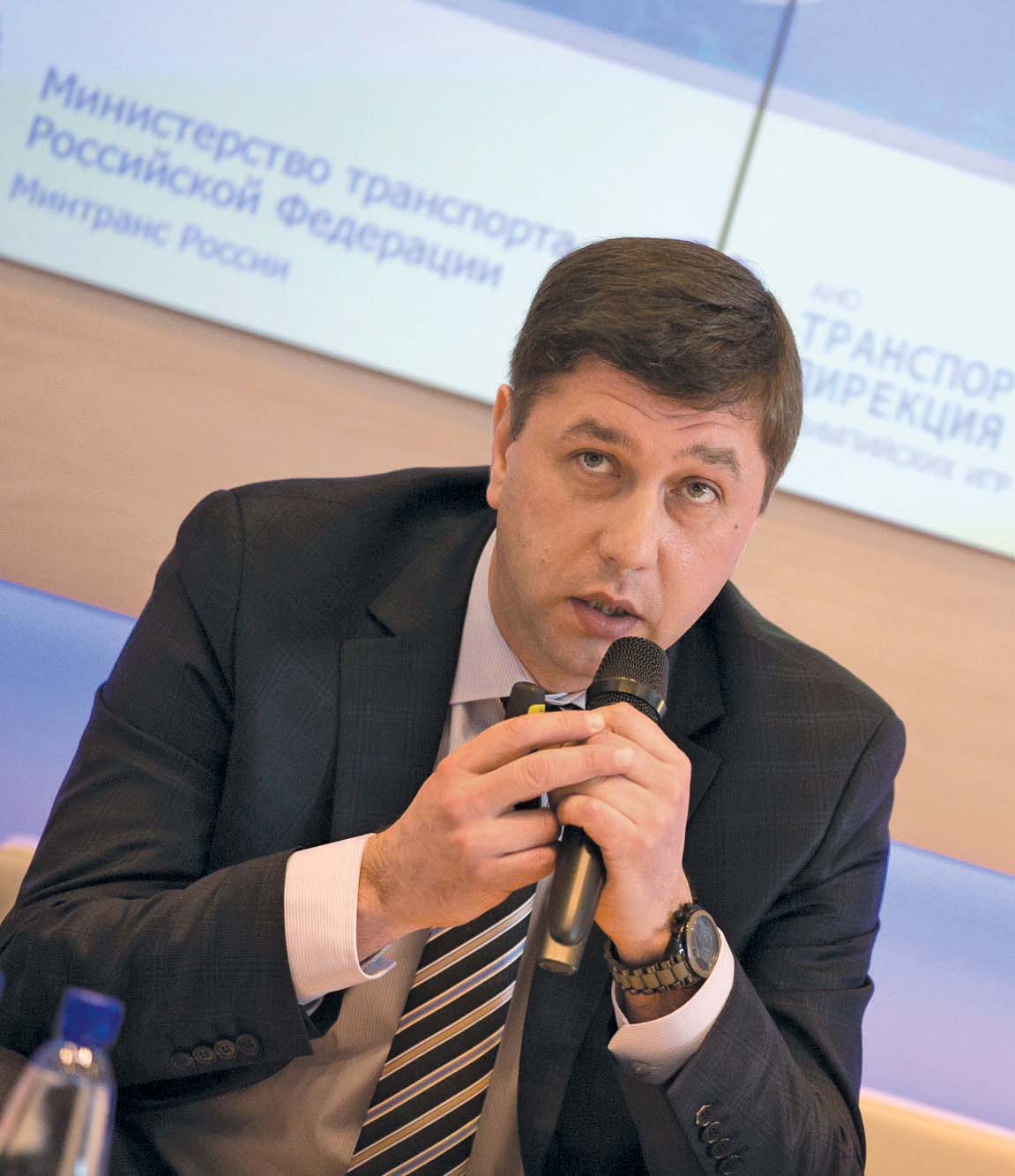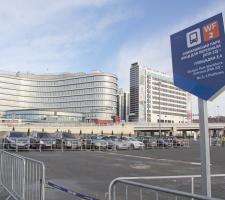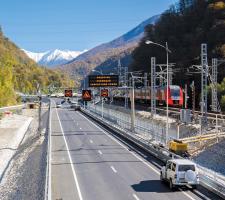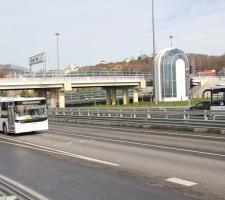
Igor Korolev of the Olympic Games Transport Directorate
Sporting events always create problems for traffic planners and none more so than the Winter Olympics.
It is difficult to think of more diametrically opposite challenges for transport planners than the 2012 Olympics in London and this year’s Winter Olympics in Sochi: from a summer event in the heart of a megacity with well established transport infrastructure to winter games with unpredictable weather and events in remote and mountainous locations. The Winter Games are always a challenge and Sochi was no different; while a single city wins the right to host the games, the reality is that the events themselves are spread over a wider area.
In the case of Sochi, much of the transport planning fell to the Olympic Games Transport Directorate’s Igor Korolev. Speaking through an interpreter Korolev mapped out the challenge: “Sochi is normally a summer holiday destination and with some of the Olympic events being hosted in different locations, the area of the games spread for 150km along the Black Sea coast. At the point Sochi was awarded the games, there was often only a single road linking one area to the next so, where possible, a second road was built.”
This included the 20km Doubler of Kurortny Avenue, designed to ease often heavy congestion on the existing four-lane (two lanes each direction) Kurortny Street, and the Sochi bypass. Nine of the new highway’s 20km pass underground through a series of 12 road tunnels which range in length from 600m-1.45km.
On other routes, such as those leading to and in the mountains, building a second access road was not always possible or practical. So around a year before the opening ceremony the transport management team assembled to devise strategies to get staff, teams, spectators and VIPs to and from all the venues and events. There was also a need to transport those preparing the venue, security personnel and the catering teams both prior to and after the event.
While VIPs were often moved by car for security reasons, most contestants, spectators, staff and others were moved to and from the venues and around the area on public transport – some local trains but mostly buses. “Normally Sochi has an average of 300 buses 9m or 10m in length running throughout the day but during the Olympics we had more than 2,000 buses operating and each was 15m in length. So although limiting measures reduced the regular background traffic by a third, overall traffic volumes were still far higher than normal,” said Korolev.
A primary aim was to prevent traffic coming to a standstill as this very quickly leads to frustration among teams and spectators. With this in mind, the decision was taken to control both the speed and density of the traffic to ensure everybody reached their destination in a timely manner. While figures on attendance were only speculative and there was very little traffic data available, modelling of many scenarios was carried out.
The strategy decided upon was to control the maximum and average speed of the traffic and to regulate both the number of vehicles and people entering and leaving each node. “The bus stands were about 500m long and these were designed with only one entrance and exit so we could control when each bus left and stagger departures as needed to avoid congestion on route or at the destination,” said Korolev.
At the outset this would have been difficult to coordinate as Sochi did not have an existing traffic control centre. So one was built in preparation for the Olympics and throughout the event it housed a team of 12 traffic controllers.
“They controlled when buses travelling to one of the venues left the depot: the first batch of buses and private cars were able to travel at the normal maximum 60km/h speed limit while with the second batch we used variable message signs to reduce the speed to 50km/h. Where possible we also sent buses travelling from one venue point to another via the most direct route while private cars were directed on a longer, less direct route. Using these methods we gave the first buses time to unload and clear the area before the private cars and second batch of buses arrived and so congestion was avoided.
“Tidal flows were also created to cater for the biggest events such as the opening and closing ceremonies.”
As would be expected technology played a big part in ensuring everything happened as it should. Live information regarding the number of people waiting to board buses at each venue and traffic flows was used to decide how many buses were needed, which route they should follow to their destination and the speed limit. “Our main task was to avoid the situation where vehicles were stopped and waiting so we aimed to keep them moving, even if at times that movement was slower than normal.”
Both radar and some 600 CCTV cameras were installed along the routes to enable the control centre to monitor traffic movement and spot any delays. Each bus was fitted with satellite navigation and was tracked via GLONASS, while live images (or buffered when the mountains interfered with the transmission) from the CCTV cameras on each bus were streamed back to the control centre. This data was used to monitor the passengers both to determine the number onboard as well as for security reasons.
At their disposal Korolev’s team had mobile traffic lights and 70 variable message signs to convey speed limits and other route specific information – 40 were deployed in the same position throughout the games and as the event went smoothly, the 20 in reserve remained unused.
That’s not to say there were no changes of plan along the way. “In the six months leading up to the Olympics we had to constantly update and change our plans because things changed. The number of supporters expected to be coming in was constantly changing and areas where they would stay also changed, so we had to redraw the plans time and time again. And even during the games themselves we had to change things three times - the original plan could not be used anymore so we had to adapt based on the models and calculations we had already devised.
“Many of these changes had to be enacted very quickly – for instance if some heads of state decide to visit a particular venue because one of their country’s athletes looked set to win a medal. In some cases we needed to create segregated one-way lanes within a five-lane highway to get them and their staff to and from the venue without encountering congestion. These lanes may stretch for 5km or 6km and were created in a few hours using the mobile traffic lights, variable message signs and other devices.”
Other demands arose from ad-hoc events: “Sometimes the winning team and their supporters decided to have a celebration, some of these unplanned and spontaneous ‘events’ were quite large and could occur almost anywhere. At the same time there could be planned events in the same area so we had to react to that.”
As is to be expected at any major event, there was extensive emergency planning - which happily remained unused. One scenario envisaged diverting traffic to avoid a road blocked by an incident - if needed this could be achieved in 1.5 to 2hrs even though the control centre was 60 or 70km away.
“We had positioned VMS and other equipment at strategic points around the area in case it was needed in a hurry – but it wasn’t,” said Korolev, adding: “We had also gone to great lengths to ensure the wording or graphics we would display in the event of an emergency would be easily understood. These had been pre-programed into the signs so they could be quickly called up if needed.”
With bus drivers and other staff drafted in from other parts of the country training and familiarisation was an essential part of the preparation and none more so than with the control room which housed 24 work stations. A dayshift during the Olympics required a crew of 12 traffic controllers and the facility was shared with security anagers. There was extra capacity should it be needed to cater for an emergency situation.
Korolev: “As there was no existing control room in Sochi we had to bring in experienced staff from other areas. We also had a mobile traffic control centre which was moved into position for the big events like the opening and closing ceremonies. I usually went to the site and worked in the mobile control centre when it was deployed.”
With the Olympics over, the mobile VMS and traffic lights have been removed but the new roads and other permanent installations remain including the ITS system and adaptive traffic lights, some of the CCTV cameras and the control centre.
“Now the Olympics are over, six people are sufficient to handle the normal volume of traffic and as many of the drafted-in traffic controllers want to return home. Some have had their contracts extended in order to train local people to operate the centre.”
So in terms of traffic management, the work done in Sochi will have a more profound and enduring beneficial effect on the local population and tourists than their equivalents in London.
It is difficult to think of more diametrically opposite challenges for transport planners than the 2012 Olympics in London and this year’s Winter Olympics in Sochi: from a summer event in the heart of a megacity with well established transport infrastructure to winter games with unpredictable weather and events in remote and mountainous locations. The Winter Games are always a challenge and Sochi was no different; while a single city wins the right to host the games, the reality is that the events themselves are spread over a wider area.
In the case of Sochi, much of the transport planning fell to the Olympic Games Transport Directorate’s Igor Korolev. Speaking through an interpreter Korolev mapped out the challenge: “Sochi is normally a summer holiday destination and with some of the Olympic events being hosted in different locations, the area of the games spread for 150km along the Black Sea coast. At the point Sochi was awarded the games, there was often only a single road linking one area to the next so, where possible, a second road was built.”
This included the 20km Doubler of Kurortny Avenue, designed to ease often heavy congestion on the existing four-lane (two lanes each direction) Kurortny Street, and the Sochi bypass. Nine of the new highway’s 20km pass underground through a series of 12 road tunnels which range in length from 600m-1.45km.
On other routes, such as those leading to and in the mountains, building a second access road was not always possible or practical. So around a year before the opening ceremony the transport management team assembled to devise strategies to get staff, teams, spectators and VIPs to and from all the venues and events. There was also a need to transport those preparing the venue, security personnel and the catering teams both prior to and after the event.
While VIPs were often moved by car for security reasons, most contestants, spectators, staff and others were moved to and from the venues and around the area on public transport – some local trains but mostly buses. “Normally Sochi has an average of 300 buses 9m or 10m in length running throughout the day but during the Olympics we had more than 2,000 buses operating and each was 15m in length. So although limiting measures reduced the regular background traffic by a third, overall traffic volumes were still far higher than normal,” said Korolev.
A primary aim was to prevent traffic coming to a standstill as this very quickly leads to frustration among teams and spectators. With this in mind, the decision was taken to control both the speed and density of the traffic to ensure everybody reached their destination in a timely manner. While figures on attendance were only speculative and there was very little traffic data available, modelling of many scenarios was carried out.
The strategy decided upon was to control the maximum and average speed of the traffic and to regulate both the number of vehicles and people entering and leaving each node. “The bus stands were about 500m long and these were designed with only one entrance and exit so we could control when each bus left and stagger departures as needed to avoid congestion on route or at the destination,” said Korolev.
At the outset this would have been difficult to coordinate as Sochi did not have an existing traffic control centre. So one was built in preparation for the Olympics and throughout the event it housed a team of 12 traffic controllers.
“They controlled when buses travelling to one of the venues left the depot: the first batch of buses and private cars were able to travel at the normal maximum 60km/h speed limit while with the second batch we used variable message signs to reduce the speed to 50km/h. Where possible we also sent buses travelling from one venue point to another via the most direct route while private cars were directed on a longer, less direct route. Using these methods we gave the first buses time to unload and clear the area before the private cars and second batch of buses arrived and so congestion was avoided.
“Tidal flows were also created to cater for the biggest events such as the opening and closing ceremonies.”
As would be expected technology played a big part in ensuring everything happened as it should. Live information regarding the number of people waiting to board buses at each venue and traffic flows was used to decide how many buses were needed, which route they should follow to their destination and the speed limit. “Our main task was to avoid the situation where vehicles were stopped and waiting so we aimed to keep them moving, even if at times that movement was slower than normal.”
Both radar and some 600 CCTV cameras were installed along the routes to enable the control centre to monitor traffic movement and spot any delays. Each bus was fitted with satellite navigation and was tracked via GLONASS, while live images (or buffered when the mountains interfered with the transmission) from the CCTV cameras on each bus were streamed back to the control centre. This data was used to monitor the passengers both to determine the number onboard as well as for security reasons.
At their disposal Korolev’s team had mobile traffic lights and 70 variable message signs to convey speed limits and other route specific information – 40 were deployed in the same position throughout the games and as the event went smoothly, the 20 in reserve remained unused.
That’s not to say there were no changes of plan along the way. “In the six months leading up to the Olympics we had to constantly update and change our plans because things changed. The number of supporters expected to be coming in was constantly changing and areas where they would stay also changed, so we had to redraw the plans time and time again. And even during the games themselves we had to change things three times - the original plan could not be used anymore so we had to adapt based on the models and calculations we had already devised.
“Many of these changes had to be enacted very quickly – for instance if some heads of state decide to visit a particular venue because one of their country’s athletes looked set to win a medal. In some cases we needed to create segregated one-way lanes within a five-lane highway to get them and their staff to and from the venue without encountering congestion. These lanes may stretch for 5km or 6km and were created in a few hours using the mobile traffic lights, variable message signs and other devices.”
Other demands arose from ad-hoc events: “Sometimes the winning team and their supporters decided to have a celebration, some of these unplanned and spontaneous ‘events’ were quite large and could occur almost anywhere. At the same time there could be planned events in the same area so we had to react to that.”
As is to be expected at any major event, there was extensive emergency planning - which happily remained unused. One scenario envisaged diverting traffic to avoid a road blocked by an incident - if needed this could be achieved in 1.5 to 2hrs even though the control centre was 60 or 70km away.
“We had positioned VMS and other equipment at strategic points around the area in case it was needed in a hurry – but it wasn’t,” said Korolev, adding: “We had also gone to great lengths to ensure the wording or graphics we would display in the event of an emergency would be easily understood. These had been pre-programed into the signs so they could be quickly called up if needed.”
With bus drivers and other staff drafted in from other parts of the country training and familiarisation was an essential part of the preparation and none more so than with the control room which housed 24 work stations. A dayshift during the Olympics required a crew of 12 traffic controllers and the facility was shared with security anagers. There was extra capacity should it be needed to cater for an emergency situation.
Korolev: “As there was no existing control room in Sochi we had to bring in experienced staff from other areas. We also had a mobile traffic control centre which was moved into position for the big events like the opening and closing ceremonies. I usually went to the site and worked in the mobile control centre when it was deployed.”
With the Olympics over, the mobile VMS and traffic lights have been removed but the new roads and other permanent installations remain including the ITS system and adaptive traffic lights, some of the CCTV cameras and the control centre.
“Now the Olympics are over, six people are sufficient to handle the normal volume of traffic and as many of the drafted-in traffic controllers want to return home. Some have had their contracts extended in order to train local people to operate the centre.”
So in terms of traffic management, the work done in Sochi will have a more profound and enduring beneficial effect on the local population and tourists than their equivalents in London.














